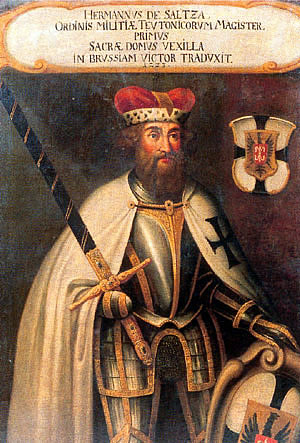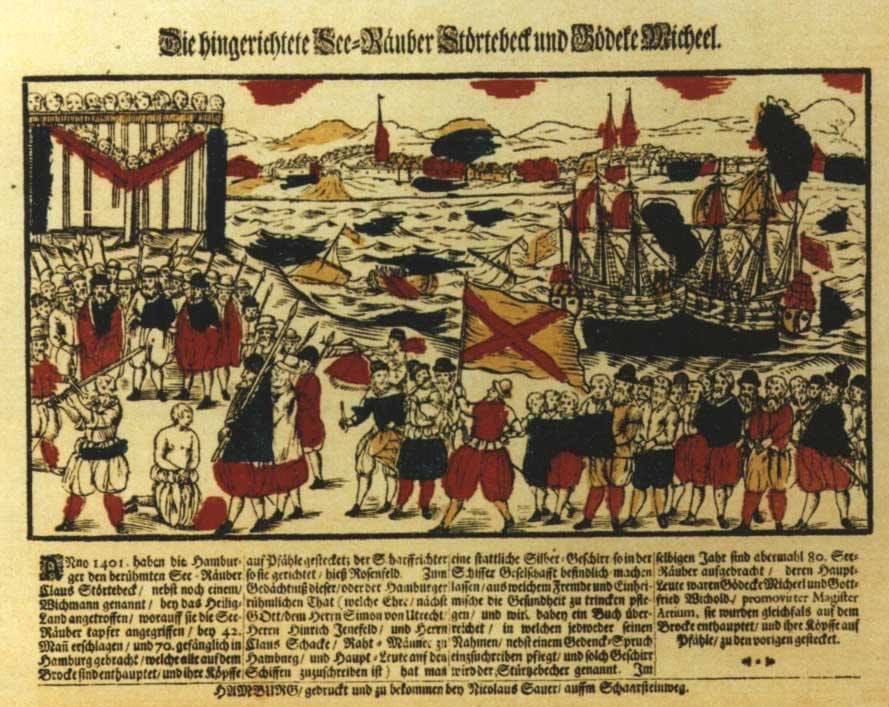|
Konrad Von Jungingen
Konrad V von Jungingen (c. 1355 – 30 March 1407) was a grand master of the Teutonic Order in 1393-1407. Under his administration the Teutonic Order would reach their greatest extent. Konrad von Jungingen came from the Swabian League. He joined the Teutonic Order together with his younger brother Ulrich around 1380. At first he was a commander at the castle in Osterode. In 1391 he was promoted to the Treasurer of Marienburg. Konrad's election to Grand Master and head of the Order arose through an indirect fashion. As chairman of the order, policy excluded him from consideration. One of the brothers, Wolf von Zolnhart, proposed his candidacy for the post of grand master. His proposal went unopposed and on 30 November 1393, they elected him unanimously as Grand Master. Konrad opted to retain most of the policies of his predecessors. However, unlike them, he chose the path of diplomacy. He interfered with the Lithuanian Civil War between the great princes – once supporting ... [...More Info...] [...Related Items...] OR: [Wikipedia] [Google] [Baidu] |
Hochmeister
The Grand Master of the Teutonic Order (german: Hochmeister des Deutschen Ordens; la, Magister generalis Ordo Teutonicus) is the supreme head of the Teutonic Order. It is equivalent to the grand master of other military orders and the superior general in non-military Roman Catholic religious orders. ''Hochmeister'', literally "high master", is only used in reference to the Teutonic Order, as ''Großmeister'' ("grand master") is used in German to refer to the leaders of other orders of knighthood. An early version of the full title in Latin was ''Magister Hospitalis Sanctae Mariae Alemannorum Hierosolymitani''. Since 1216, the full title ''Magister Hospitalis Domus Sanctae Mariae Teutonicorum Hierosolymitani'' ("Master of the Hospital House of the Blessed Virgin Mary of the Germans of Jerusalem") was used. The offices of ''Hochmeister'' and ''Deutschmeister'' (''Magister Germaniae'') were united in 1525. The title of ''Magister Germaniae'' had been introduced in 1219 as t ... [...More Info...] [...Related Items...] OR: [Wikipedia] [Google] [Baidu] |
Grand Duchy Of Lithuania
The Grand Duchy of Lithuania was a European state that existed from the 13th century to 1795, when the territory was partitioned among the Russian Empire, the Kingdom of Prussia, and the Habsburg Empire of Austria. The state was founded by Lithuanians, who were at the time a polytheistic nation born from several united Baltic tribes from Aukštaitija. The Grand Duchy expanded to include large portions of the former Kievan Rus' and other neighbouring states, including what is now Lithuania, Belarus and parts of Ukraine, Latvia, Poland, Russia and Moldova. At its greatest extent, in the 15th century, it was the largest state in Europe. It was a multi-ethnic and multiconfessional state, with great diversity in languages, religion, and cultural heritage. The consolidation of the Lithuanian lands began in the late 13th century. Mindaugas, the first ruler of the Grand Duchy, was crowned as Catholic King of Lithuania in 1253. The pagan state was targeted in a religious crusad ... [...More Info...] [...Related Items...] OR: [Wikipedia] [Google] [Baidu] |
Kuyavia
Kuyavia ( pl, Kujawy; german: Kujawien; la, Cuiavia), also referred to as Cuyavia, is a historical region in north-central Poland, situated on the left bank of Vistula, as well as east from Noteć River and Lake Gopło. It is divided into three traditional parts: north-western (with the capital in Bydgoszcz, ethnographically regarded often as non-Kuyavian), central (the capital in Inowrocław or Kruszwica), and south-eastern (the capital in Włocławek or Brześć Kujawski). Etymology The name Kuyavia first appeared in written sources in the 1136 Bull of Gniezno ( pl, Bulla Gnieźnieńska, Latin: ''Ex commisso nobis'') issued by Pope Innocent II, and was then mentioned in many documents from medieval times. It is also mentioned in the chronicles of Wincenty Kadłubek. Geography In the north, Kuyavia borders with the historic regions of Gdańsk Pomerania ( Pomerelia) and Chełmno Land, in the west with proper (exact) Greater Poland, in the south with Łęczyca Land and i ... [...More Info...] [...Related Items...] OR: [Wikipedia] [Google] [Baidu] |
Margaret I Of Denmark
Margaret I ( da, Margrete Valdemarsdatter; March 1353 – 28 October 1412) was ruler of Denmark, Norway, and Sweden (which included Finland) from the late 1380s until her death, and the founder of the Kalmar Union that joined the Scandinavian kingdoms together for over a century. She had been Norway's queen consort 1363–1380 and Sweden's 1363–1364, since then titled ''Queen''. Margaret was known as a wise, energetic and capable leader, who governed with "farsighted tact and caution," earning the nickname " Semiramis of the North". She was derisively called "King Breechless", one of several derogatory nicknames invented by her rival Albert of Mecklenburg, but was also known by her subjects as "Lady King", which became widely used in recognition of her capabilities. Knut Gjerset calls her "the first great ruling queen in European history." The youngest daughter of King Valdemar IV of Denmark, Margaret was born at Søborg Castle. She was a practical, patient administrator and ... [...More Info...] [...Related Items...] OR: [Wikipedia] [Google] [Baidu] |
Kalmar Union
The Kalmar Union ( Danish, Norwegian, and sv, Kalmarunionen; fi, Kalmarin unioni; la, Unio Calmariensis) was a personal union in Scandinavia, agreed at Kalmar in Sweden, that from 1397 to 1523 joined under a single monarch the three kingdoms of Denmark, Sweden (then including most of present-day Finland), and Norway, together with Norway's overseas colonies Norway retained none of its prior possessions, however. Christian I pledged the Northern Isles to Scotland as insurance for his daughter’s dowery in 1468; when the dowery wasn’t paid the islands transferred to perpetual Scottish sovereignty in 1470. Following the Union’s dissolution, all remaining overseas possessions brought into the Union by Norway became property of the Danish monarch; who retained ownership following the transfer of the Kingdom of Norway from the Danish crown to Swedish crown (discussed in further detail below) after the Napoleonic Wars. (then including Iceland, Greenland, Nominal possession. ... [...More Info...] [...Related Items...] OR: [Wikipedia] [Google] [Baidu] |
Visby
Visby () is an urban area in Sweden and the seat of Gotland Municipality in Gotland County on the island of Gotland with 24,330 inhabitants . Visby is also the episcopal see for the Diocese of Visby. The Hanseatic city of Visby is arguably the best-preserved medieval city in Scandinavia, and, since 1995, it has been on the UNESCO World Heritage Site list. Among the most notable historical remains are the long town wall that encircles the town center, and a number of church ruins. The decline as a Hanseatic city in the Late Middle Ages was the cause why many stone houses were preserved in their original medieval style. Visby is a popular vacation destination for Scandinavians during the summer and receives thousands of tourists every year. It is by far the most populous Swedish locality outside the Swedish mainland. The Gotland University is in Visby, and, since 1July 2013, it is a department of Uppsala University under the name Uppsala University–Campus Gotland. Visby is ... [...More Info...] [...Related Items...] OR: [Wikipedia] [Google] [Baidu] |
Baltic Sea
The Baltic Sea is an arm of the Atlantic Ocean that is enclosed by Denmark, Estonia, Finland, Germany, Latvia, Lithuania, Poland, Russia, Sweden and the North and Central European Plain. The sea stretches from 53°N to 66°N latitude and from 10°E to 30°E longitude. A marginal sea of the Atlantic, with limited water exchange between the two water bodies, the Baltic Sea drains through the Danish Straits into the Kattegat by way of the Øresund, Great Belt and Little Belt. It includes the Gulf of Bothnia, the Bay of Bothnia, the Gulf of Finland, the Gulf of Riga and the Bay of Gdańsk. The "Baltic Proper" is bordered on its northern edge, at latitude 60°N, by Åland and the Gulf of Bothnia, on its northeastern edge by the Gulf of Finland, on its eastern edge by the Gulf of Riga, and in the west by the Swedish part of the southern Scandinavian Peninsula. The Baltic Sea is connected by artificial waterways to the White Sea via the White Sea–Baltic Canal and to ... [...More Info...] [...Related Items...] OR: [Wikipedia] [Google] [Baidu] |
Victual Brothers
, native_name_lang = , named_after = french: vitailleurs (provisioners, Hundred Years' War) , image = Vitalienbrueder, Wandmalerei in d, Kirche zu Bunge auf Gotland, gemalt ca. 1405.JPG , image_size = 250px , alt = , caption = A contemporary representation of the ''Vitalienbrüder'' on a wall painting, Bunge church, Gotland, Sweden, , logo = , logo_size = , logo_alt = , logo_caption = , map = , map_size = , map_alt = , map_caption = , map2 = , map2_size = , map2_alt = , map2_caption = , abbreviation = , motto = , predecessor = , merged = , successor = , formation = ca. 1393 , founder = , founding_location = , dissolved = ca. 1440 , merger = ... [...More Info...] [...Related Items...] OR: [Wikipedia] [Google] [Baidu] |
Gotland
Gotland (, ; ''Gutland'' in Gutnish), also historically spelled Gottland or Gothland (), is Sweden's largest island. It is also a province, county, municipality, and diocese. The province includes the islands of Fårö and Gotska Sandön to the north, as well as the Karlsö Islands (Lilla and Stora) to the west. The population is 61,001, of which about 23,600 live in Visby, the main town. Outside Visby, there are minor settlements and a mainly rural population. The island of Gotland and the other areas of the province of Gotland make up less than one percent of Sweden's total land area. The county formed by the archipelago is the second smallest by area and is the least populated in Sweden. In spite of the small size due to its narrow width, the driving distance between the furthermost points of the populated islands is about . Gotland is a fully integrated part of Sweden with no particular autonomy, unlike several other offshore island groups in Europe. Historically there w ... [...More Info...] [...Related Items...] OR: [Wikipedia] [Google] [Baidu] |
Albert Of Sweden
Albert (german: Albrecht, sv, Albrekt av Mecklenburg; c. 1338 – 1 April 1412) was King of Sweden from 1364 to 1389 and Duke of Mecklenburg-Schwerin from 1384 to 1412. Background He was the second son of Duke Albert II of Mecklenburg and Euphemia Eriksdotter, the daughter of Duke Erik Magnusson of Södermanland and sister of King Magnus IV of Sweden, Magnus VII of Norway. Albert married Richardis of Schwerin, daughter of count Otto of Schwerin. Queen Richardis died in 1377 and was buried in Stockholm. In 1384 he inherited the ducal title of Mecklenburg and united it with Sweden in a personal union. Albert based his claims to the Swedish crown upon his family ties: his mother being Magnus's sister, whose paternal grandfather was King Magnus III, Albert claimed first place in the Swedish order of succession after the dethronement or deaths of all of the children of Magnus IV; and through a Swedish princess Christina, a daughter of Sverker II who was King of Sweden from 1 ... [...More Info...] [...Related Items...] OR: [Wikipedia] [Google] [Baidu] |


.png)
.jpg)



